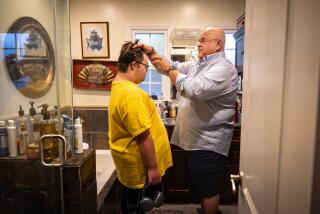The Word They Use Is <i> Scary</i>
We have been visiting doctors, nurses, technicians and administrators in the wards and clinics that serve people infected with the human immunodeficiency virus (HIV) that causes AIDS, asking them to assess the situation. The word they used most often was scary.
Demand for services is outpacing development of new services. Thousands will be denied life-extending therapies, identified by the National Institute of Allergies and Infectious Diseases last summer, unless there is a rapid expansion of programs. But no new money is in sight. Clearly, the crisis in AIDS-related services and facilities, thought to be years away, is here and now.
Los Angeles County alone would have to triple its budget next year to provide the early intervention procedures recommended by the U.S. Public Health Service. Orange County estimates that its facilities can meet less than half the demand for new services. Already there are waits as long as eight weeks for out-patient services in Los Angeles County, with waiting lists, even for the dying, for access to hospice care. Los Angeles County exhausted its AIDS home-care budget in the first five months of the fiscal year and has had to divert $650,000 from other health care to keep the program going. Home care is under review amidst growing concerns about the cost, averaging $8,000 a month, higher than a residential nursing facility. Yet there are only 100 beds in residential nursing facilities for AIDS patients in Los Angeles County, and most of those beds are not state- licensed and therefore not useable for Medi-Cal or other publicly funded patients.
Throughout the state there is a serious shortage of skilled AIDS health-care workers. The new West Hollywood Clinic, intended to be a model for early intervention for HIV-infected persons, is running at 75% of its target capacity, short two nurses and relying on part-time physicians instead of the full-time doctor planned initially. Three-fourths of the nurses in the AIDS ward at Los Angeles County/USC Medical Center are hired from a nurses’ registry because the hospital has been unable to recruit enough permanent staff. The staff of the dental clinic of AIDS Project Los Angeles has declined to the time equivalent of one dentist, forcing patients to wait as long as four months for non-emergency procedures.
Some progress is being made. California has received a supplementary federal grant of$5.4 million for AZT and other prescription drugs, and that money is now being distributed to the counties. The money cannot be used for the cost of health-care workers required to monitor early interventions, however. The new West Hollywood Clinic is developing a program of early intervention for the HIV-positive population that can later be offered at regional health centers as funds and staff become available. The Los Angeles County/USC Medical Center’s new 20-bed AIDS wards, as attractive and up to date as any facility of its sort in the nation, is operating at capacity. Ground will be broken soon for a new out-patient AIDS clinic at County/USC that will double the capacity of existing facilities, alleviating the clinic over-crowding and shortening the waiting time that now runs as long as eight weeks.
The critical new challenge now is to provide the early intervention services that are the key to extending the lives of HIV-infected persons. Development of these new procedures, according to Dr. Louis S. Sullivan, secretary of health and human services, represents a “significant milestone in the battle to change AIDS from a fatal disease to a treatable one.” But the cost is high. Los Angeles County, with an estimated 112,000 persons with the HIV infection, expects the demand for county-provided early intervention to rise to 30,000, but now can serve only 2,000. And so it is in most other areas of the state and the nation.
The prospect is indeed scary.
More to Read
Sign up for Essential California
The most important California stories and recommendations in your inbox every morning.
You may occasionally receive promotional content from the Los Angeles Times.










